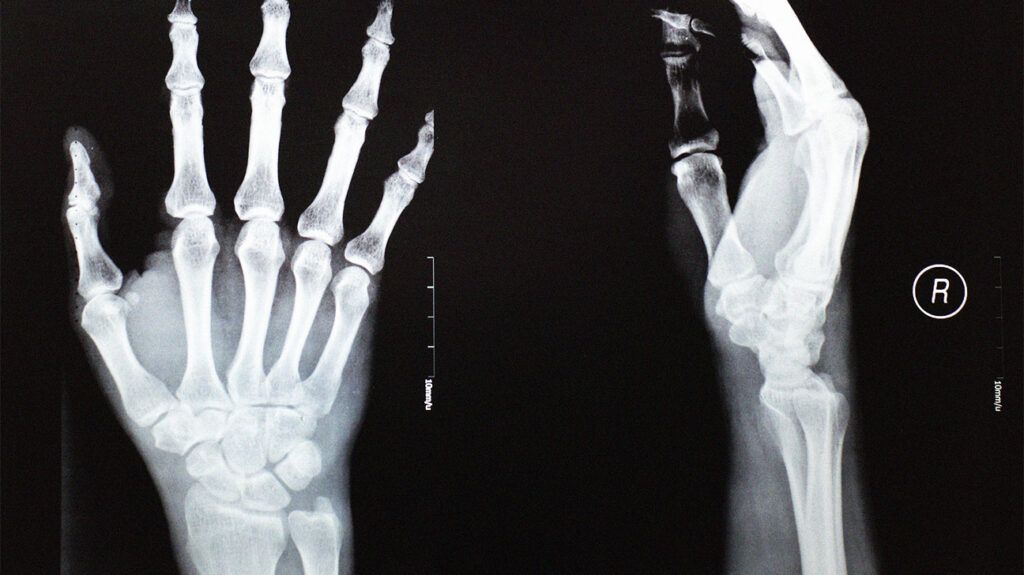Chondromas are noncancerous growths that can occur on a person’s hands or feet. These benign tumors consist of cartilage, the connective tissue that protects the ends of bones.
Doctors categorize chondromas into four main types, depending on where on the bones they grow:
- enchondromas that grow inside the bone
- osteochondromas that grow out from the bone
- periosteal chondromas that start in the tough membrane surrounding every bone
- soft tissue chondromas that grow on tendons
Although these tumors are benign, both enchondromas and osteochondromas can become malignant.
This article explores the different types of chondromas and their symptoms and treatment.

People with chondromas may notice lumps near the joints of their fingers or toes. Chondromas can also form on other bones.
Many individuals do not have symptoms, and doctors only discover the chondromas during other routine examinations.
Osteochondromas are usually painless, but people with enchondromas in their hands or feet may experience fractures since the tumors can weaken the bones and cause structural issues.
Symptoms can vary depending on where the tumor grows.
For example, if a tumor grows underneath a tendon, a person may experience pain when moving their joint.
Experts do not know what causes chondromas.
Osteochondromas are more common in children and adolescents than adults since these tumors develop around bone growth plates. Growth plates are areas of cartilage at the end of long bones that slowly harden into bone.
Because experts do not know why people develop chondromas, they also cannot identify risk factors.
However, they know individuals are more likely to develop different types of chondroma at different ages.
Osteochondromas are more common in people between the ages of 10 and 30. Additionally, the majority of those with periosteal chondromas are younger than 30.
Doctors usually diagnose people with soft tissue chondromas when they are middle-aged.
Very occasionally, those with enchondroma develop multiple tumors. Doctors associate these tumors with either Ollier’s disease or Maffucci syndrome. People with multiple tumors have a slightly higher risk of developing cancer than those with just one lump.
Doctors may diagnose people with chondromas after taking X-rays for other injuries or arthritis. A person with enchondroma may fracture their fingers or toes, and X-rays may reveal the tumors as the underlying cause.
If a doctor identifies a lump or growth during a physical examination, they will likely order imaging tests such as additional X-rays, CT scans, and MRIs. CT scans and MRIs are particularly useful for detecting periosteal and soft tissue chondromas, which may not show on X-rays.
Doctors will also ask people if they have any pain and when it occurs. Pain at night or rest may signal potential malignancy.
If doctors suspect the tumors are cancerous, they may recommend a biopsy to rule out other, more aggressive forms of cancer. During a biopsy, doctors remove a small tissue sample from the tumor for examination under a microscope.
Treatment differs depending on the type of chondroma a person has.
For example, surgery may be the best option to treat soft tissue or periosteal chondromas since they are not usually attached to a person’s bones.
Many people with enchondroma or osteochondroma do not need treatment. However, if the tumor is blocking blood vessels or putting pressure on someone’s nerves, doctors may recommend surgery.
If a person with enchondroma needs surgery, doctors usually recommend curettage with bone grafting. During this procedure, doctors scrape the tumor away from the bone and then fill the cavity with a bone graft to strengthen and stabilize the bone.
Most people with chondroma do not have any symptoms and do not need surgery or treatment. Doctors monitor the tumors to ensure they do not become malignant or cause pain.
The recovery time for people who have surgery depends on where the tumors are and whether or not they have had bone grafts.
There is a
Chondromas are noncancerous tumors that start in the cartilage within bones.
Most people with chondroma do not have symptoms and may not even notice the growth. Doctors may discover their existence while diagnosing other conditions.
In most cases, doctors employ a wait-and-see approach with chondromas. However, treatment may be necessary if the growths are painful or put pressure on nerves.
